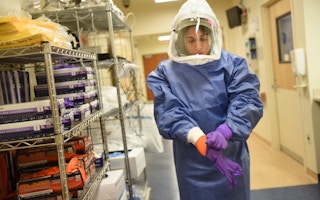As has been widely reported, protocols regarding the usage of personal protective equipment (PPE) have evolved as cases have rapidly escalated around the world.
For example, Britian’s guidance is that healthcare workers should replace their gowns and aprons after treating each patient and face masks after each shift. Other countries initially had similar guidelines in place; however, as in the case with Britain, started to relax them, given PPE shortages.
The growth in and deployment of technologies to decontaminate and reuse certain types of PPE has also witnessed an impressive uptick in recent months.
However, even with these changes in how PPE is used and managed, treating such a large number of COVID-19 patients and, particularly, those with serious cases, creates a tremendous amount of biohazard medical waste.
For example, Hubei province, which was the epicenter of the outbreak, has already reported a 6-fold increase in its medical waste, while the virus may be leaving major Southeast Asian cities with an additional 1,000 tonnes of medical waste per day.
“
However, hopefully, this crisis will yield new ideas and inventive approaches to tackling the medical waste and other long-standing public health and environmental challenges that this pandemic has exacerbated.
Of course, there is a vast global medical waste sector with several well-established, well-equipped players, including Veolia Environmental Services, Stericycle, Suez Environmental Services, and Waste Management Inc. among others.
They often manage outsourced solutions for hospitals and other healthcare facilities. There are signs, however, that even these large, well-resourced corporations are facing challenges in handling the volume. In fact, this piece from France 24 captures the scale of this problem well.
And, of course, the treatment and disposal processes, which often include incineration and landfill (post-treatment), can also raise concerns regarding eventual negative climate and other environmental impacts, particularly in situations where less professional and well-resourced actors do not comply with local guidelines and regulations.
When examining this problem, one can see how a myriad of innovations could help to address this issue.
On the front end, as mentioned earlier, there are a growing number of innovations that involve the reuse of PPE equipment, particularly to address the N95 mask shortage.
One example that received fast-track approval last month from the FDA is the Battelle Critical Care Decontamination System, which can decontaminate thousands of N95 respirators at a time through a process that uses concentrated, vapor-phase hydrogen peroxide.
To address the construction of the mask itself, there is the MakerMask Initiative, the first open-source 3D printable respirator-quality mask approved by the National Institute of Health (NIH) that can be reused when coupled with proper sterilization procedures, which presents a very interesting concept.
There is also A Mask For All, a US, Argentinian, and European citizen-driven initiative, and provides an alternative 3D-printable, decontaminable mask solution.
Even if we can significantly reduce the number of disposed masks, there are countless other types of disposable PPE and medical waste that will remain.
Fortunately, there are some interesting emerging innovations to address that challenge, all of which are designed with sustainability at the core of their approach. They aim to achieve this, firstly, through on-site medical waste treatment solutions and leveraging technologies that do not rely on incineration.
One example is Israel-based Envomed, whose Envomed 80 machine shreds and sterilizes up to 80 liters of sharps (e.g., needles, syringes, etc.) and infectious waste, and converts it to non-toxic residue that can be safely disposed of as municipal waste.
Ireland-based Technopath Clinical Diagnostics’ solution, the Envotec 200, also uses a non-thermal process with no dangerous chemicals to shred and disinfect medical waste on site, with the end product being equivalent to household waste. It is gaining traction in the US, where it is now being used by Northwell Health, New York’s largest healthcare provider.
Finally, another interesting innovation is one that is in its final stages of development here in Japan. The “SmartContainer” is a 40-ft onsite container that will enable hospitals to process up to 20 tons of medical waste per day.
What makes this solution particularly interesting is that it draws on existing pyrolysis technology currently being deployed to address our colossal plastic waste problem. By using plasma pyrolysis technology, the unit can safely kill thermally-stable bacteria and limit toxic gases to well within emission standards.
Medical systems will ultimately need to assess the costs of these new innovations compared to the status quo. However, hopefully, this crisis will yield new ideas and inventive approaches to tackling the medical waste and other long-standing public health and environmental challenges that this pandemic has exacerbated.
Trista Bridges is co-founder and principal of Read the Air. She is also author of Leading Sustainably (forthcoming).













